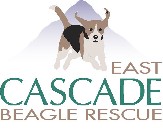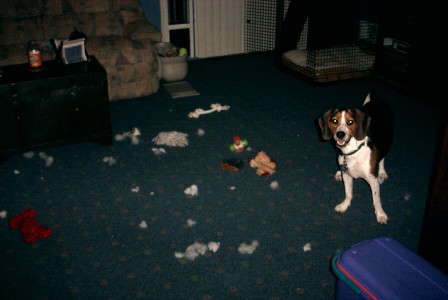
Featured Articles

Mission Statement
To place Beagles in need into
loving, permanent homes and to provide educational resources to help
prevent future displaced Beagles.
Our program is funded by private
donations. Your support is appreciated!
June 2006
Unwrapping the mystery of Separation Anxiety
First, know that you are not alone if you have a dog that has Separation Anxiety (S.A.). It is one of the most common conditions seen by animal behaviorists. Being left alone to some dogs can be a devastating experience but its symptoms can be lessened by following some of the suggestions in this article.
How do you know if it’s anxiety or just bad behavior?
Here are some clues…
![]() If
your dog chews on inappropriate personal items (your socks, your panties,
your favorite chair) but only when you aren’t home it could be S.A
If
your dog chews on inappropriate personal items (your socks, your panties,
your favorite chair) but only when you aren’t home it could be S.A
![]() If you come home and discover that your dog has tried to escape (moldings
around windows/doors are chewed) it could be S.A
If you come home and discover that your dog has tried to escape (moldings
around windows/doors are chewed) it could be S.A
![]() If
your dog howls/barks/scratches at the door the minute you leave it could
be S.A
If
your dog howls/barks/scratches at the door the minute you leave it could
be S.A
![]() If
you are at home but have segregated the dog to another room and he
continues to act out because he can’t see you it could be S.A
If
you are at home but have segregated the dog to another room and he
continues to act out because he can’t see you it could be S.A
Separation Anxiety happens almost always when you’re not there and your dog acts out in a stressful, destructive manner in his/her panic in response to the experience of being left alone. Excessive panting, whining, barking, crying, chewing, digging, scratching, howling, destructive behavior all are symptoms of S.A. and their degree of severity varies from dog to dog.
Typically, the longer the dog is alone, the worse his anxiety becomes and sadly, sometimes injuries occur if the dog reaches a panic state.
What causes Separation Anxiety?
No one knows for certain why some dogs develop it while others don’t. Separation anxiety occurs in homes with multiple dogs, single dogs – no one is immune! There are however, some common things which can trigger symptoms of Separation Anxiety including:
![]() Changes in a dogs schedule
Changes in a dogs schedule
![]() Moving to a new home
Moving to a new home
![]() Animals with a history of abuse have a higher risk of developing
separation anxiety than dogs that have had a “gentle” life.
Animals with a history of abuse have a higher risk of developing
separation anxiety than dogs that have had a “gentle” life.
![]() Poorly socialized dogs frequently have anxiety issues
Poorly socialized dogs frequently have anxiety issues
What you can do to make life easier for you both
Remember that Separation Anxiety is an instinctive disorder and not the result of bad training. Keeping that fact in mind will prevent you for blaming yourself for your dog’s problems. That being said, you are responsible for helping your dog adjust to your lifestyle so that you both live in a stress free, happy home. To create a warm environment that your dog feels safe in, try these suggestions.
Try to make leaving and coming home as uneventful as possible. We know that your dog is happy to see you when you first walk in after being out all day, but resist the urge to make a fuss by acting in a manner that is as low key as possible. Making a huge fuss over your own comings/goings will serve as a queue for your dog’s negative behavior. When you first come home, give your dog a “hello” and wait (if you can) for 5 minutes until you really greet him.
Help your dog recognize you’re going to leave by signaling him (pick up your keys as if you were going to leave but DON’T). If you act like you’re leaving and go through the mechanics of doing that, you can “trick” your dog into thinking that you’re going out so that he doesn’t associate you picking up your car keys with your actual departure.
Dogs need exercise – it will help tire him out. Since dogs sleep most of the day when tired enough, increase his daily exercise. Mental stimulation is great – it allows your dog to explore new scents, scenery and it burns off extra calories.
Give your dog something positive to do while you’re gone. Stuff a Kong toy with low fat peanut butter or buy a plain sterilized bone and stuff it with slices of apples, carrots for sweet, low fat treats.
Crate the dog – when dogs are confined to a small area they feel safer. If however, your dog has severe separation anxiety a crate may not work for you and never – I repeat – NEVER push or force a dog into a crate. Your dog will associate the crate with a negative.
What if it’s SERIOUS?
True separation anxiety is typically characterized by a dog that causes real property damage (chews holes in the wall, rips apart a sofa, etc). Unfortunately the dog often injures himself in the process. I once came home to a dog who had tried to claw his way out of his crate, only to rip a nail nearly out of its nail bed – very nasty and no doubt painful.
Serious separation anxiety is no joke – and often you need a professional trainer. But before doing that, please try these suggestions:
Practice short absences. If you have desensitized your dog to your departure queues suggested earlier, over the span of a weekend practice leaving/coming home for very short intervals. Increase the time away, progressively so that your dog learns how to associate your leaving with your quick return.
If you want to, leave on a radio or TV for white noise – sometimes the silence for a dog of being alone is deafening.
Hire a behaviorist if your dog’s destructive tendencies are causing him physical injury
Medications that can help:
Some new medications like Clomicalm can support your dog in conquering anxiety. Note, though that some of the prescriptive meds take a few weeks to build up sensitization so these meds, while effective are not a magic bullet.
Homeopathic methods work very well and there are several good ones on the market. No doubt the most common is “Rescue Remedy”, a Bach Flower Essence mix which can be administered via a dropper or a cream. Animals Apawthecary also makes a product called “Tranquility Blend” which too is an all natural approach to the problem.
For more information and to purchase either product please visit Bama’s Natural Instinct.
For further information please consider reading one of these wonderful books that thoroughly covers Separation Anxiety and remember that if you choose to purchase these, you can help Cascade by buying through the links below!
|
|
|
|
|
|
Click here to visit the article archives.
Mission Statement
To place Beagles in need into
loving, permanent homes and to provide educational resources to help
prevent future displaced Beagles.
Our program is funded by private
donations. Your support is appreciated!
